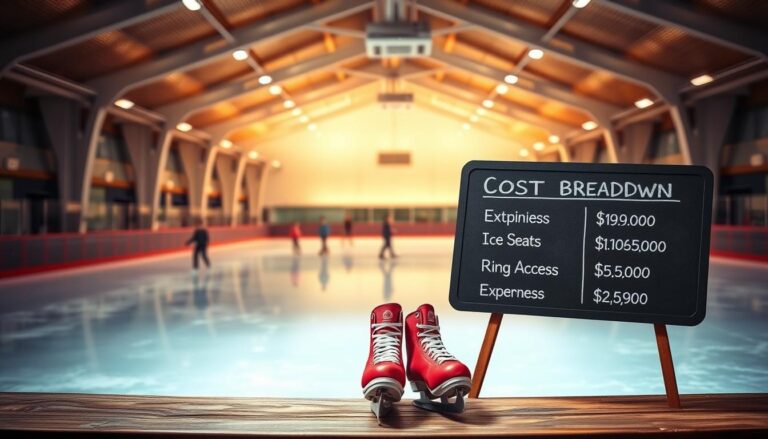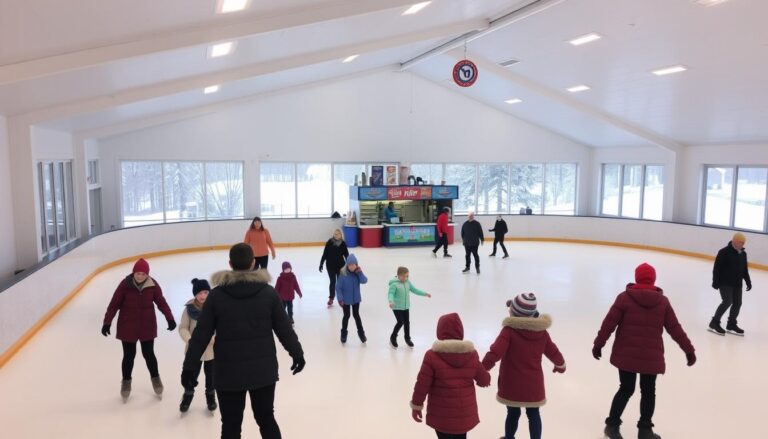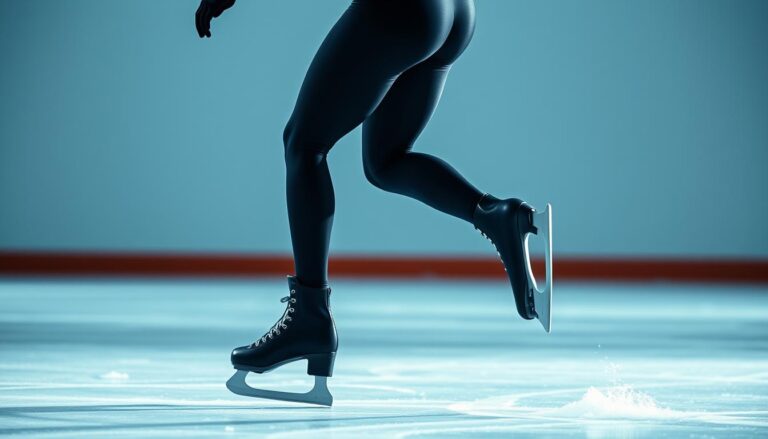Speed Skating 101: Everything You Need to Know
Imagine a sport that combines speed, precision, and athletic power. Speed skating is more than a sport; it’s an adrenaline rush. It turns ordinary athletes into ice-gliding champions. Whether you’re into fitness or dream of the Olympics, speed skating is exciting.
Speed skating is not just about moving fast on ice. It requires incredible leg strength, endurance, and technique. Skaters can hit speeds of up to 35 miles per hour, showing off human power and skill.
The sport started in Northern Europe’s frozen lands, where skating was a way to get around. Now, it’s a sophisticated Olympic event with different disciplines. Each one tests athletes in unique ways, from long track to short track.
Starting out might seem daunting with the sleek suits and sharp blades. But speed skating welcomes all levels. You’ll build strong legs, boost your heart health, and learn to combine grace with power. The journey is tough, but the rewards are worth it.
Professional skaters train hard, focusing on technique, strength, and mental prep. Their hard work turns them into elite athletes. They break records and represent their countries worldwide.
This guide will cover everything about speed skating. You’ll learn its history, techniques, gear, and the physical and mental challenges. Whether you aim for the Olympics or just want a new fitness challenge, speed skating has something for you.
Get ready to explore a sport that pushes your limits, boosts your fitness, and connects you with a global community. This community lives for the thrill of gliding at incredible speeds.
What Is Speed Skating: A Comprehensive Introduction
Speed skating is a thrilling winter sport that mixes power, precision, and top-notch athletic skill. When you step onto the ice, you enter a world where athletes zoom by at incredible speeds. They race on frozen surfaces, where every millisecond counts.
Understanding speed skating means grasping the mix of technique, strength, and strategy. Athletes use long, special blades to glide efficiently and with little friction.
Olympic vs Recreational Speed Skating
The speed skating world has two main areas:
- Olympic Speed Skating: It’s a top-level, competitive racing with strict rules.
- Recreational Speed Skating: It’s for everyone, focusing on fun and fitness.
Key Characteristics of the Sport
Speed skating stands out with its unique features:
- Low, aerodynamic skating position
- Powerful leg movements
- Precision turning techniques
- Specialized equipment for top speed
Basic Principles and Goals
Speed skating is all about cutting down resistance and boosting speed. Athletes work to:
- Keep the most efficient body position
- Make strong leg pushes
- Turn with less energy loss
- Get the fastest time
Whether you’re a pro or just enjoy it on weekends, speed skating is an exciting way to feel the rush of ice and speed.
The Rich History of Speed Skating Through the Ages
Speed skating has a long history, starting as a way to travel in winter. It evolved into a popular Olympic sport. The sport began in the Netherlands, where people used skates to move on frozen canals.
The early days of speed skating are quite interesting:
- 12th Century: First documented ice skating in the Netherlands
- 1676: First organized skating competition recorded
- 1852: First official speed skating competition held
- 1889: International Skating Union (ISU) established
As technology improved, so did speed skating. Steel blades, aerodynamic suits, and new training methods changed the game. They made the sport faster and more precise.
| Era | Key Development | Impact on Speed Skating |
|---|---|---|
| 1800s | Introduction of Steel Blades | Increased Speed and Precision |
| 1920s | Olympic Recognition | Global Competitive Platform |
| 1990s | Aerodynamic Suit Design | Significant Performance Improvements |
Today, speed skating is loved by fans all over the world. It combines athleticism with cutting-edge technology. From Dutch canals to modern indoor tracks, it’s a story of human spirit and innovation.
Different Types of Speed Skating Disciplines
Speed skating is not just one sport. It has many exciting disciplines that test athletes in different ways. Each discipline requires special skills, techniques, and strategies, making the sport diverse and exciting.
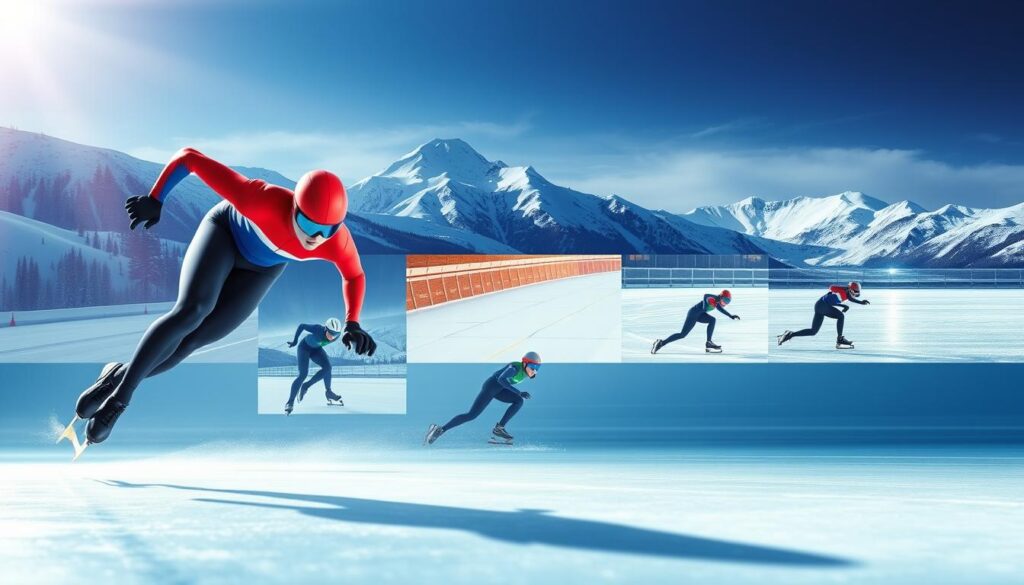
Professional speed skaters train in various disciplines, each with its own unique features and challenges. Let’s look at the most well-known types of speed skating that thrill athletes and fans globally.
Long Track Speed Skating
Long track speed skating is the classic Olympic sport. Skaters race on a huge 400-meter oval, focusing on individual time trials and speed. The big track lets athletes show off their technical skill and power.
- Races usually range from 500 to 10,000 meters
- Skaters compete in paired lanes
- It emphasizes smooth, efficient technique
Short Track Speed Skating
Short track speed skating is different from long track. It features intense, pack-style racing on a small rink. This discipline is known for its high-energy, NASCAR-like competition where many skaters race at once.
- Smaller 111-meter oval track
- Multiple skaters compete in direct competition
- It requires exceptional agility and tactical racing
Marathon Speed Skating
Marathon speed skating is the ultimate test of endurance. These races can be very long, pushing athletes to their limits.
- Races can extend up to 150 kilometers
- It requires exceptional cardiovascular endurance
- Often performed on natural ice surfaces
Each type of speed skating offers a unique challenge, attracting athletes with different strengths and interests. Whether you prefer precision, pack dynamics, or endurance, there’s a speed skating discipline for you.
Essential Speed Skating Equipment and Gear
Getting into speed skating is more than just a hobby. You need the right gear to do your best. The right equipment can greatly improve your performance, safety, and overall experience.
Here’s what you’ll need to start:
- Speed Skating Boots: Special boots for flexibility and power
- Blades: Long, sharp blades for speed
- Skin-tight racing suits to cut wind resistance
- Protective gear like helmets, knee pads, and gloves
Finding the right fit is key. Your boots should support your ankles but also be flexible. Skaters often spend a lot of time finding the perfect fit.
| Equipment Type | Key Considerations |
|---|---|
| Boots | Ankle support, material flexibility, custom fitting |
| Blades | Length, sharpness, material quality |
| Racing Suit | Aerodynamic design, compression, lightweight material |
You don’t have to spend a lot on good speed skating gear. Start with the basics and upgrade as you get better. Many local skating clubs can help you choose the right gear for beginners.
Proper Speed Skating Techniques and Form
Mastering speed skating takes precision, practice, and knowing the basics. Whether you’re new or aiming high, getting your form right is key to success on the ice.
Speed skating is all about being efficient and powerful. The right moves can turn you from a beginner to a pro. Let’s explore the essential parts to help you move smoothly and fast.
Basic Skating Position
Your journey in speed skating begins with the right stance. Skaters know that how you stand is vital. Here’s what makes a great speed skating stance:
- Bend your knees at a 90-degree angle
- Keep your back straight and parallel to the ice
- Distribute weight evenly on the skating edge
- Position arms for balance and aerodynamics
Crossovers and Turns
Mastering turns is what sets top skaters apart. Speed skating techniques for crossovers include:
- Maintaining low body position
- Using inside and outside edges strategically
- Practicing smooth weight transfer
- Generating momentum through hip rotation
Starting Techniques
A strong start can win you the race. Explosive acceleration needs specific techniques that blend strength and skill:
- explosive push-off from starting line
- Quick, synchronized arm and leg movements
- Maintaining low center of gravity
- Minimizing energy waste during initial acceleration
Keep practicing these techniques, and you’ll see big improvements in your speed skating.
Speed Skating Training Methods and Programs
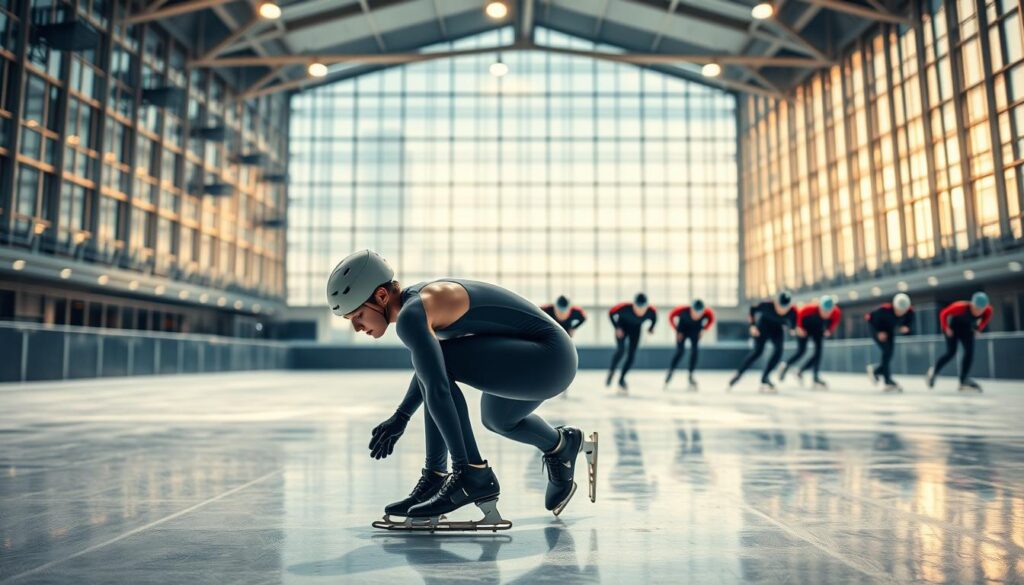
Creating a strong speed skating training program needs a smart plan. It must mix different training parts. Athletes aiming to be top in this fast-paced sport must prepare fully, not just skate on ice.
Good speed skating training includes several key parts:
- On-ice technical skill development
- Off-ice strength conditioning
- Cardiovascular endurance training
- Flexibility and mobility work
Building strong muscles and heart health is key. Interval training helps build the quick power needed for fast skating.
Training Program Breakdown
A typical speed skating training program might include:
- Strength training targeting leg muscles
- Core stability exercises
- Plyometric workouts
- Balance and coordination drills
Top speed skaters spend 15-20 hours a week training. They mix on-ice and off-ice work. Rest and avoiding injuries are also key parts of their training.
| Training Type | Focus Area | Frequency |
|---|---|---|
| On-Ice Technical Training | Technique Refinement | 4-5 times/week |
| Strength Conditioning | Muscle Development | 3-4 times/week |
| Cardiovascular Training | Endurance Building | 5-6 times/week |
Speed skaters should team up with coaches for custom training plans. These plans should focus on their strengths and areas to get better.
Understanding Speed Skating Racing Formats
Speed skating competitions are thrilling. They show off athletes’ amazing skills and strategy. These races push the limits of human speed and endurance in different ways.
Speed skating has many racing formats. Each one tests athletes’ skills, speed, and tactics. Skaters need different techniques and mental strategies for each format.
Individual Races: The Ultimate Speed Challenge
Individual speed skating is the purest test of speed and technique. Athletes race against the clock in various distances. From short sprints to long races, they face different challenges.
- 500-meter sprint: Explosive power and acceleration
- 1,000-meter race: Balance of speed and endurance
- 5,000-meter event: Strategic pacing and mental strength
- 10,000-meter marathon: Ultimate test of endurance
Team Pursuit Events: Synchronized Speed
Team pursuit speed skating is all about teamwork. Skaters must coordinate and draft to be fast and efficient. It’s a race where teamwork is key.
| Team Pursuit Characteristics | Key Requirements |
|---|---|
| Team Size | 3-4 skaters |
| Race Distance | 4,000-8,000 meters |
| Strategy | Synchronized movement and drafting |
Mass Start Competitions: Tactical Battles
Mass start speed skating is intense. Many skaters race at once, making it a thrilling competition. Strategy and position are everything.
- All skaters start together on the track
- Points awarded for intermediate sprints
- Final lap determines overall winner
- Requires advanced tactical skills
Each speed skating format is unique. They test athletes’ physical and mental limits. From solo races to team pursuits and mass starts, these events highlight the skill and determination of speed skaters.
Physical Benefits of Speed Skating
Speed skating turns your body into a strong athletic machine. It’s more than just exercise. It’s a full-body workout that works many muscles at once.
When you hit the ice, you’re in for a high-energy workout. Speed skating offers many physical benefits, including:
- Burning up to 800 calories per hour
- Building strong lower body muscles
- Boosting heart health
- Strengthening your core
Speed skating works your muscles in a special way. It uses both slow-twitch and fast-twitch fibers. This is a better workout than most other exercises.
| Muscle Group | Engagement Level | Performance Impact |
|---|---|---|
| Quadriceps | High | Power generation |
| Glutes | Moderate to High | Stability and propulsion |
| Core Muscles | High | Balance and control |
| Calves | Moderate | Ankle strength |
Speed skating is great for those who want to avoid joint stress. It’s a low-impact sport. This means it’s easier on your knees and ankles compared to running or high-impact sports.
Want to get fit? Speed skating is a fun and effective way to boost your health, strength, and athletic skills.
Mental Aspects and Strategy in Speed Skating
Speed skating is more than just physical strength. The mental game is key to becoming a top performer. Knowing the psychological side of speed skating can give athletes a big advantage.

Race Tactics: Mastering Strategic Thinking
Good speed skaters use smart race tactics. These tactics include:
- Reading opponent movements
- Identifying optimal positioning
- Calculating energy conservation
- Timing strategic acceleration
Psychological Preparation Techniques
Top athletes use special mental training. These techniques include:
- Visualization exercises
- Breathing control methods
- Stress management protocols
- Focused meditation practices
Competition Mindset Development
Building a strong competition mindset takes practice. Athletes need to turn nervous energy into focused performance.
| Mental Skill | Performance Impact |
|---|---|
| Emotional Regulation | Reduces performance anxiety |
| Goal Visualization | Increases motivation |
| Resilience Training | Improves recovery from setbacks |
Mental strength can be the deciding factor in speed skating. By combining mental and physical training, athletes can reach their full ice performance.
Major Speed Skating Competitions and Events
Speed skating competitions are the top of athletic achievement worldwide. Athletes from everywhere come together. They show off their amazing skills and test the limits of human performance on ice.
The international speed skating calendar has many big events. These events attract top athletes and fans:
- Winter Olympic Games
- ISU World Single Distance Championships
- ISU World Cup Series
- World Sprint Championships
- National Championships
Every competition offers its own challenges and chances for speed skaters to show their talents. The Winter Olympics are the biggest stage. Here, national pride and personal achievement meet.
| Competition | Frequency | Location Highlights |
|---|---|---|
| Winter Olympics | Every 4 Years | Rotating International Venues |
| World Single Distance | Annual | Various International Locations |
| World Cup Series | Seasonal | Multiple Countries |
Professional speed skating competitions test athletes’ skills, endurance, and strategy. Competitive venues range from high-altitude tracks in Salt Lake City to iconic outdoor ovals in European countries.
If you love speed skating or dream of becoming an athlete, these competitions are exciting. They show the amazing abilities of humans and athletes.
Notable Speed Skating Records and Achievements
Speed skating world records are the top of human athletic achievement on ice. They show the amazing skill, hard work, and strength of the world’s best athletes. These athletes break records, showing what humans can do.
The world of speed skating records is exciting. Athletes from everywhere try to beat old records. They make incredible moments that thrill fans and motivate others.
World Record Highlights
- Pavel Kulizhnikov holds the men’s 500m world record at an astonishing 33.61 seconds
- Brittany Bowe set the women’s 1000m world record with a time of 1:11.61
- The Netherlands dominates international speed skating world records
Olympic Record Breakthroughs
Olympic speed skating records are the highest achievements in the sport. These moments are celebrated as the best in athletic history. The Olympic stage is where athletes show their incredible talents.
| Event | Record Holder | Time | Year |
|---|---|---|---|
| Men’s 5000m | Ted-Jan Bloemen | 6:01.86 | 2018 |
| Women’s 3000m | Martina Sáblíková | 3:53.31 | 2018 |
Historical Milestones
Speed skating has changed a lot over the years. Important milestones include new ice skates, better training, and track tech. These changes have pushed human speed limits.
- 1960s: First standardized international speed skating competitions
- 1990s: Introduction of the clap skate revolutionized technique
- 2000s: Advanced aerodynamic suits improved performance
These records are more than numbers. They show what humans can do with hard work, new ideas, and determination.
Common Speed Skating Injuries and Prevention
Speed skating is very demanding, which can cause injuries if you don’t take care. Knowing how to protect yourself is key to enjoying its benefits.
Speed skaters face special challenges that need specific injury prevention plans. Common injuries include:
- Knee joint stress
- Lower back strain
- Muscle pulls in quadriceps and hamstrings
- Ankle ligament damage
To avoid injuries, you need to use the right techniques. This keeps you safe and lets you get the most out of speed skating.
| Injury Type | Prevention Strategy | Recovery Time |
|---|---|---|
| Knee Strain | Strength training, proper warm-up | 2-4 weeks |
| Ankle Ligament Damage | Ankle stability exercises, protective gear | 4-6 weeks |
| Lower Back Pain | Core strengthening, correct posture | 1-3 weeks |
Experts say to start slowly to avoid injuries. This lets your body get used to harder training and enjoy speed skating more.
Important prevention tips are:
- Regular stretching routines
- Investing in high-quality protective equipment
- Working with experienced coaches
- Maintaining proper skating technique
By knowing the risks and using smart training, athletes can safely enjoy speed skating. This way, they can get the physical and mental benefits without getting hurt.
Speed Skating Venues and Training Facilities
Finding the right place to train in speed skating is key for athletes aiming for the top. There are top-notch indoor ovals and outdoor tracks. These places are where dreams of skating greatness come true.
Top speed skating training spots are amazing feats of engineering. The Utah Olympic Oval and Thialf in the Netherlands are examples of the best. They control the ice’s temperature, humidity, and quality to help athletes train hard.
- Indoor ovals with precise environmental controls
- Outdoor tracks for diverse training conditions
- Specialized ice maintenance technologies
- Advanced timing and performance tracking systems
Local skaters have many places to train:
- Community ice rinks
- Regional skating clubs
- Municipal sports complexes
- University athletic facilities
Pro tip: Not every speed skating training facility requires Olympic-level investment. Many athletes start on community rinks, learning the basics before moving to special venues.
Today’s speed skating training spots use cool tech like laser tracking and real-time analytics. These tools help athletes improve their skills and reach new speeds on ice.
Getting Started in Speed Skating
Starting your speed skating journey is both thrilling and tough. It’s perfect for those who love fitness or winter sports. Speed skating lets you improve your athletic skills and feel the rush of gliding on ice.
Getting into speed skating needs careful planning and hard work. The right steps can turn you into a confident skater, ready to dive into this exciting sport.
Finding the Right Coach
Finding a good speed skating coach is key. Look for someone with a strong background who can:
- Check your current skating skills
- Create a training plan just for you
- Teach you the right way to skate and stay safe
- Give you feedback and keep you motivated
Joining a Speed Skating Club
Joining a local speed skating club can really help you grow. These groups offer:
- Structured training spots
- Access to top-notch gear
- Chances to meet and learn from experienced skaters
- Opportunities to compete in events
Initial Training Steps
Your first steps in speed skating should focus on basic skills. Start with balance exercises, learn the right skating stance, and then move on to more advanced moves.
Pro tip: Being consistent in your training is vital. Regular practice helps build muscle memory and boosts your performance.
Remember, every pro skater started where you are now. Be patient, stay committed, and enjoy learning this thrilling sport!
Rules and Regulations in Speed Skating

Speed skating might seem simple, but it has a lot of rules. These rules make sure the competition is fair and everyone stays safe. Knowing these rules is key for anyone interested in speed skating.
The world of speed skating has strict rules for everything. Athletes must follow a detailed guide that covers equipment and racing rules. It’s all about precision and skill.
Key Regulatory Areas
- Equipment Regulations
- Starting Procedures
- Racing Conduct
- Safety Requirements
Equipment rules are very strict. Skaters must use approved skates that meet certain standards. Blade length, boot construction, and material are all checked to keep things fair.
| Rule Category | Primary Requirements | Potential Penalties |
|---|---|---|
| Skate Specifications | Blade length max 45cm, fixed to boot | Disqualification |
| Racing Lane Conduct | No intentional blocking or interference | Time penalty or elimination |
| Starting Protocol | False start results in immediate penalty | Position reset or disqualification |
Racing conduct has its own set of rules. These include how to change lanes, pass others, and keep a safe distance. Short track speed skating is all about knowing where you are and following the rules closely.
Safety is always the top priority. Athletes must wear approved gear like helmets and suits. Before races, referees check the equipment to make sure it’s safe.
If you’re into speed skating or just love watching it, knowing the rules makes it even more interesting. Speed skating is not just about being fast. It’s about skill, strategy, and doing everything right.
Conclusion
Speed skating is more than a sport; it’s a mix of skill and excitement. At its heart, it’s a sport that combines power, technique, and mental strength. It’s enjoyed by athletes everywhere, from the Olympics to local rinks.
Speed skating does more than just keep you fit. It’s a full-body workout that boosts your heart health, strengthens your legs, and improves balance. It also builds mental toughness that helps in other life areas.
Speed skating is open to everyone, from beginners to pros. It starts with a single step onto the ice. With hard work, the right skills, and passion, anyone can become a skilled skater.
Your speed skating journey is waiting. Get your gear, join a local club, and meet coaches. The ice is ready, and your possibilities are endless. Dive in, feel the thrill, and find the athlete inside you!


